最新译林版牛津小学英语4B全册教案
译林版4B全册教案

三、根据你所听到的问句,选择正确的答句。
(5分) ( )1.A.No,I don ’t. B.I like English. ave PE. ( )2.A.They are on the sofa. B. It ’s in the bedro ’t. ( )3.A. I can see a bird. B. Yes I can. ( )4. A. Sorry ,let ’s go. B. Good idea.放录音找答案指名说针对性讲解sister,Tina. She is seven.Today is7:00.We go to school at Chinese,English and Science.But she doesn likes Music, Art and PE.We go home at 4()Peter is seven,Tina is eleven. ()Today is Tuesday.()They get up at seven thirty. ()Tina likes PE()They go home at four fifteen.T: Yes, there’re four. Let’s look at the pictures. How beautiful!1. Learn about the seasons.T: Look at the picture, what can you see in it ?S: I can see…T: Can you guess which season is it? Now it’s spring.(学习spring) Are you hot? Are you cold?S: No.T: So it’s warm in spring. We can do many interesting things in spring. (学习warm)Ss: read after teacher.T: It is warm, I fly kites. What else can we do in spring? Just use this sentence structure.Ss: 学生学说T: In this season, it isn’t hot, or cold, either. It is yellow. The farmers like this season. Which season is it? Ss: 秋天T: Yes, it’s autumn. (学习 autumn) And it’s cool. Here “cool” means 凉爽的.We know it has another meaning is 酷的,漂亮的。
译林英语新版4B教案
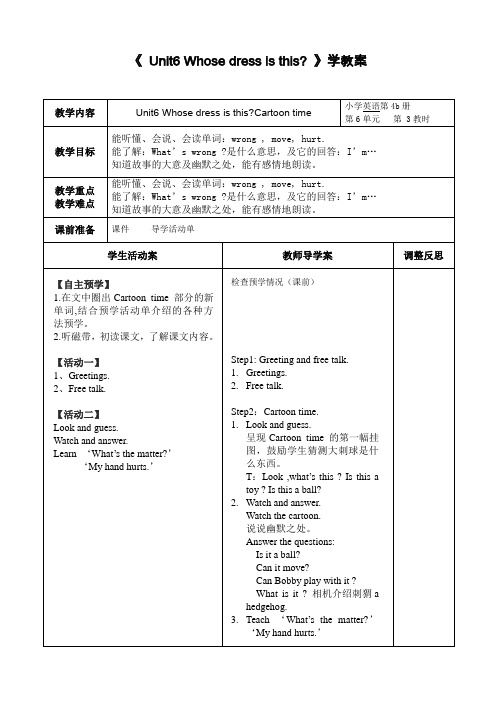
学生活动案
教师导学案 联系上下文,看图片猜测句子 的含义。 Read after the teacher. 4. Listen choose ,and imitate. 听录音选择正确的语气, 并跟读模 仿语音语调。 (1)What’s this ? It can move. A.afraid B surprised C.curiousy (2)What’s the matter? A.afraid B surprised C.worry (3)Nice to meet you. A.friendly B surprised C.anger 边完成选择,边听录音仿读。 5. Listen andimitate. 边看边跟读,模仿语音语调。 6. Group work :Let’s dub. Work in groups Show time: How many stars can you get? Step4:Homework.
课件 导学活动单
教学重点 教学难点 课前准备
学生活动案 【自主预学】 1.在文中圈出 Cartoon time 部分的新 单词 , 结合预学活动单介绍的各种方 法预学。 2.听磁带,初读课文,了解课文内容。 【活动一】 1、Greetings. 2、Free talk. 【活动二】 Look and guess. Watch and answer. Learn ‘What’s the matter?’ ‘My hand hurts.’
Recite Cartoon time
调整反思
【活动三】 Listen choose ,and imitate. 听录音选择正确的语气,并跟读模仿 语音语调。 完成选择,边听录音仿读这些句子。
【活动四】 Listen andimitate. 边看边跟读,模仿语音语调。 【活动五】 【训练提升】 Let’s dub.
牛津小学英语4B全册教案
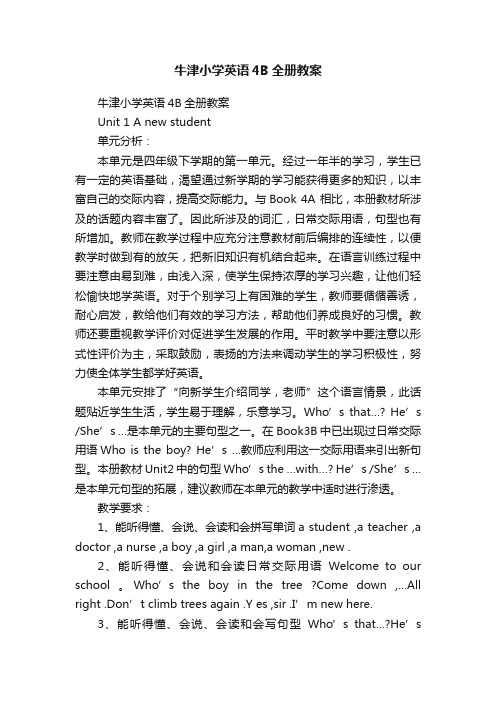
牛津小学英语4B全册教案牛津小学英语4B全册教案Unit 1 A new student单元分析:本单元是四年级下学期的第一单元。
经过一年半的学习,学生已有一定的英语基础,渴望通过新学期的学习能获得更多的知识,以丰富自己的交际内容,提高交际能力。
与Book 4A 相比,本册教材所涉及的话题内容丰富了。
因此所涉及的词汇,日常交际用语,句型也有所增加。
教师在教学过程中应充分注意教材前后编排的连续性,以便教学时做到有的放矢,把新旧知识有机结合起来。
在语言训练过程中要注意由易到难,由浅入深,使学生保持浓厚的学习兴趣,让他们轻松愉快地学英语。
对于个别学习上有困难的学生,教师要循循善诱,耐心启发,教给他们有效的学习方法,帮助他们养成良好的习惯。
教师还要重视教学评价对促进学生发展的作用。
平时教学中要注意以形式性评价为主,采取鼓励,表扬的方法来调动学生的学习积极性,努力使全体学生都学好英语。
本单元安排了“向新学生介绍同学,老师”这个语言情景,此话题贴近学生生活,学生易于理解,乐意学习。
Who’s that…? He’s /She’s …是本单元的主要句型之一。
在Book3B 中已出现过日常交际用语Who is the boy? He’s …教师应利用这一交际用语来引出新句型。
本册教材Unit2中的句型Who’s the …with…? He’s /She’s …是本单元句型的拓展,建议教师在本单元的教学中适时进行渗透。
教学要求:1、能听得懂、会说、会读和会拼写单词a student ,a teacher ,a doctor ,a nurse ,a boy ,a girl ,a man,a woman ,new .2、能听得懂、会说和会读日常交际用语Welcome to our school 。
Who’s the boy in the tree ?Come down ,…All right .Don’t climb trees again .Y es ,sir .I’m new here.3、能听得懂、会说、会读和会写句型Who’s that…?He’s/She’s …Are you …? Y es ,I am .No ,I’m not .I’m a …4、了解辅音字母w和z在单词中的读音。
牛津译林版四年级英语下册4B Project 2 A party教案
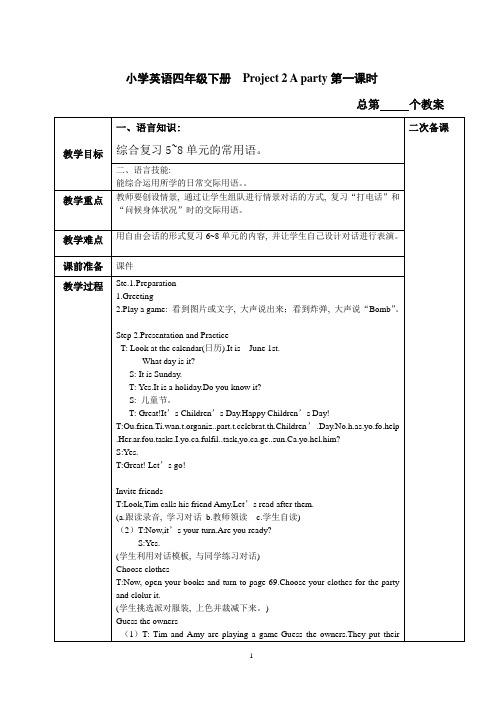
S7: Awoman.
T: Who’s thewoman?
S8:She’s Yang Ling’saunt.
T: Good, can you make a chant for me?
(设计意图:编写chant,帮助学生复习本单元的主要人称,以及实际的理解能力)
T: Nowlook, is it nice?
Ss: How beautiful! (Students enjoy some pictures.)
T: Whereare they?
Ss:On a farm
T.Thi.i..magi.farm.Wha.ca.yo.see.(Student.loo.an.tr.t.fin.out.)
... It’.war..ho..coo..cold.
This is / These are my…for the party.
This is a…/ These are…(用颜色描述服装)
教后反思
(第篇)
小学英语四年级下册Project A party第二课时
总第个教案
教学目标
一、语言知识:
1.能听懂、会说5—8单元的农场动物类、水果类的单词、数词以及介词等。
课前准备
课件
教学过程
Ste.1.Preparation
1.Greeting
2.Play a game:看到图片或文字,大声说ห้องสมุดไป่ตู้来;看到炸弹,大声说“Bomb”。
Step 2.Presentation and Practice
T: Look at the calendar(日历).It is June 1st.
牛津小学英语4B全册教案

牛津小学英语4B全册教案四年级英语全册教案《牛津小学英语4B》第一单元教案The First Period (第一课时) 一、教学内容:Unit 1 B: Look, read and learn C: Ask and answer 二、教学目标:1、学生能听得懂、会说、会读和会拼写单词:student, a teacher, a doctor, a nurse. a 2、学生能听得懂、会说、会读和会写句型:Who’s that boy / girl / man / woman? He’s / She’s… He’s/ She’s a… 3、学生能听懂、会说、会读日常交际用语:Welcome back to school. 4、初步熟悉歌曲:Who’s that boy? 5、通过“认人”的语言学习,培养学生实际运用英语进行交流的能力和乐于于人交流、合作的个性。
三、教学重点:四会单词和句型的听、说、读、写. 四、教学难点:能正确的使用”he” 与”she”. 五、教学准备:1、人物职业图和Yang Ling 等人物图片。
2、准备学生照片两张,老师照片一张,每个学生准备自己家庭成员的照片若干。
3、录音机、磁带。
六、教学过程:Step 1. Free talk 1、以Good morning / afternoon, boys and girls. How are you? / How are you this morning / afternoon / today? Nice to see you! / Glad to see you! Are you happy today? / How old are you? 等和学生招呼,学生依照情形回答。
2、在与每位学生问候结束时,送上一句Welcome back to school. Step 2. Presentation and practice 1、Good morning, boys and girls . Nice to see you! Welcome back to school. 出示Welcome back to school. 理解并领读。
译林版牛津小学英语4B Unit 7 At a snack bar教案

牛津小学英语4B Unit 7 At a snack bar教学方案4A Unit 7 教学方案(第一课时)第一部分简要提示一、年级:4年级二、单元:Unit 7三、课题:At a snack bar四、课型:新授课五、教学内容:单元Part A六、教学目标:1、能听懂、会说、会读单词hamburger, noodles, juice, coffee,2、能听懂、会说、会读句型How about you? Some…, please. Somethingto drink? Anything else?七、重难点:初步了解句型:How about you? Some…, please. Something todrink?Anything else?第二部分教学过程第一步:重难点突破T:Hello, boys and girls. Nice to meet you.同学们,你们好,今天我们学习牛津小学英语4B第七单元At a snack bar。
你们知道什么是snack bar 吗?(课件出示图片)Look, this is a snack bar.snack bar指的是小吃店,snack的意思是小吃,零食。
T:There are many food in it. What can you see?T:(PPT出示图片:cake, noodles, hamburgers, pies, tea, milk, juice, coffee)(老师依次带读并教授)So many delisious food. 这么多好吃的东西,Would you like something to eat or drink?你想要吃点或喝点什么吗?(PPT出示句型‘Something to eat/Something to drink?’,带读)I’d like some hamburgers and some coffee. 我想要一些汉堡包和咖啡。
最新译林牛津小学英语原创精品公开赛课集体备课教学设计 4B Unit6_Whose_dress_is_this 整单元 9
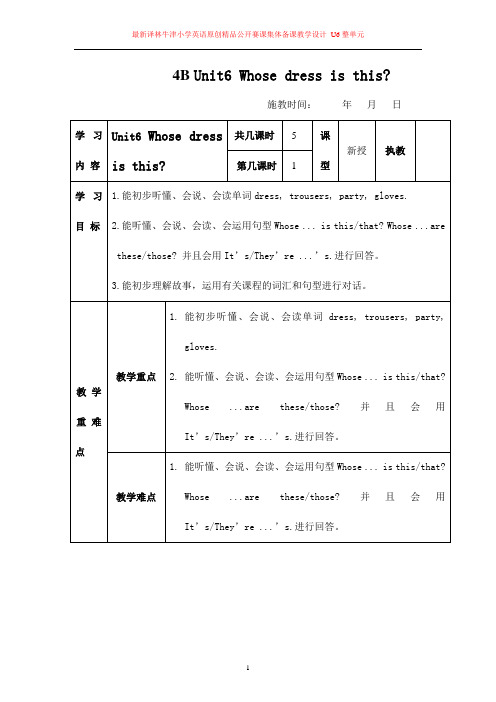
Step 2: Free talk(5分钟)
1.师生问候,交流关于课程的问题。
Step 3: Presentation(24分钟)
2.跟读U6单词表。
学 程 预 设
导 航 策 略
调整与反思
Step 1: Learning aims(1分钟)
1.能初步听懂、会说、会读单词dress, trousers, party, gloves.
2.能听懂、会说、会读、会运用句型Whose ... is this/that? Whose ...are these/those? 并且会用It’s/They’re ...’s.进行回答。
教学难点
1.能听懂、会说、会读、会运用句型Whose ... is this/that? Whose ...are these/those? 并且会用It’s/They’re ...’s.进行回答。
教学资 源
1.学生已有的学习经验:在三、四年级上学期的学习中已经学过有关的衣物类单词,并对其进行描述。
2.能理解并且流利朗读小诗。
教学难点
1.能理解并且流利朗读小诗。
教学资 源
1.学生已有的学习经验:学生在上节课已经学习过关键句子。
2.学生学习本课内容时可能出现的错误:回答时易漏掉名词所有格。
3. 教学策略:注意让学生进行回忆、比较,让学生找差别,进行牢固记忆。
4.教学准备:PPT,单词图片,预先写好课题
3.能初步理解故事,运用有关课程的词汇和句型进行对话。
Step 2: Free talk(2分钟)
与老师的进行简单交流。
Step 3: Pre—reading(10分钟)
1.Talk about our things
牛津小学英语4B全册教案

牛津小学英语4B全册教案Unit 1 A new student单元分析:本单元是四年级下学期的第一单元。
经过一年半的学习,学生已有一定的英语基础,渴望通过新学期的学习能获得更多的知识,以丰富自己的交际内容,提高交际能力。
与Book 4A 相比,本册教材所涉及的话题内容丰富了。
因此所涉及的词汇,日常交际用语,句型也有所增加。
教师在教学过程中应充分注意教材前后编排的连续性,以便教学时做到有的放矢,把新旧知识有机结合起来。
在语言训练过程中要注意由易到难,由浅入深,使学生保持浓厚的学习兴趣,让他们轻松愉快地学英语。
对于个别学习上有困难的学生,教师要循循善诱,耐心启发,教给他们有效的学习方法,帮助他们养成良好的习惯。
教师还要重视教学评价对促进学生发展的作用。
平时教学中要注意以形式性评价为主,采取鼓励,表扬的方法来调动学生的学习积极性,努力使全体学生都学好英语。
本单元安排了“向新学生介绍同学,老师”这个语言情景,此话题贴近学生生活,学生易于理解,乐意学习。
Who’s that…? He’s /She’s …是本单元的主要句型之一。
在Book3B 中已出现过日常交际用语Who is the boy? He’s …教师应利用这一交际用语来引出新句型。
本册教材Unit2中的句型Who’s the …with…? He’s /She’s …是本单元句型的拓展,建议教师在本单元的教学中适时进行渗透。
教学要求:1、能听得懂、会说、会读和会拼写单词a student ,a teacher ,a doctor ,a nurse ,a boy ,a girl ,a man,a woman ,new .2、能听得懂、会说和会读日常交际用语Welcome to our school 。
Who’s the boy in the tree ?Come down ,…All right .Don’t climb trees again .Y es ,sir .I’m new here.3、能听得懂、会说、会读和会写句型Who’s that…?He’s /She’s …Are you …? Y es ,I am .No ,I’m not .I’m a …4、了解辅音字母w和z在单词中的读音。
苏教版译林牛津英语4B全册教案
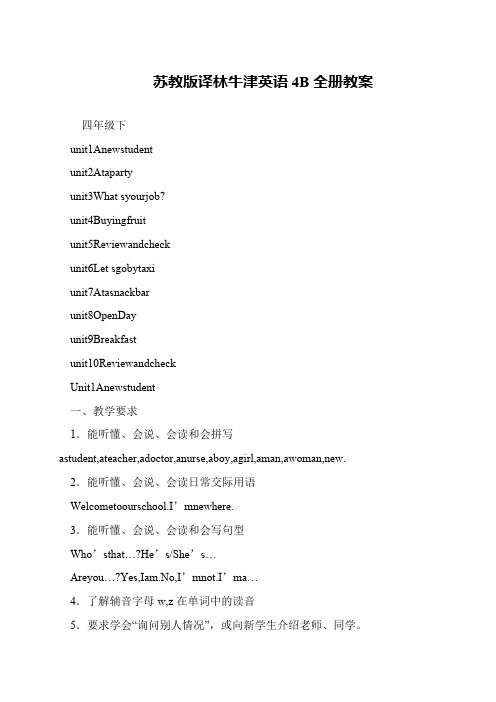
6.能在口头及书面上正确区分 he 和 she。 7.会唱歌曲 Who’stha元。经过一年半的学习,学生已有一定的 英语基础,渴望通过新学期的学习能获得更多的知识,以丰富自己的交际内 容,提高交际能力。教师在教学过程中要注意教材前后编排的连续性,把新 旧知识有机结合起来。 本单元安排了“向新学生介绍老师、同学”这个语言情景,此话题贴近学生 生活,学生易于理解,乐意学习。在教学过程中教师注意多创设情景,让学 生在语言情景中理解和操练,力求做到运用自如。此外,教师要充分利用表 情和动作,让学生去理解接受,并通过表演去巩固运用。本单元的主要句型 是 Who’sthat…?He’s/She’s…在 Book3B 中已经出现过日常交际用语 Who’sthatboy?He’s…教师应该利用这一交际用语来引出新句型。在本册接 下列的 Unit2
苏教版译林牛津英语 4B 全册教案
四年级下 unit1Anewstudent unit2Ataparty unit3What syourjob? unit4Buyingfruit unit5Reviewandcheck unit6Let sgobytaxi unit7Atasnackbar unit8OpenDay unit9Breakfast unit10Reviewandcheck Unit1Anewstudent 一、教学要求 1.能听懂、会说、会读和会拼写 astudent,ateacher,adoctor,anurse,aboy,agirl,aman,awoman,new. 2.能听懂、会说、会读日常交际用语 Welcometoourschool.I’mnewhere. 3.能听懂、会说、会读和会写句型 Who’sthat…?He’s/She’s… Areyou…?Yes,Iam.No,I’mnot.I’ma… 4.了解辅音字母 w,z 在单词中的读音 5.要求学会“询问别人情况”,或向新学生介绍老师、同学。
牛津小学英语4B全册教案
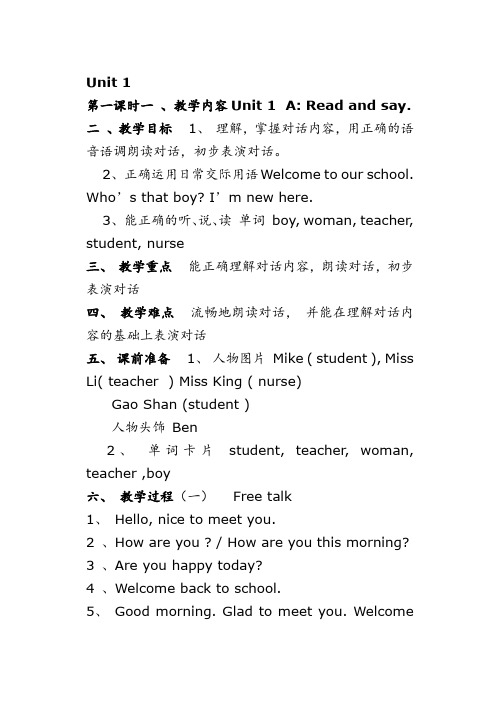
Unit 1第一课时一、教学内容Unit 1 A: Read and say.二、教学目标1、理解,掌握对话内容,用正确的语音语调朗读对话,初步表演对话。
2、正确运用日常交际用语Welcome to our school. Who’s that boy? I’m new here.3、能正确的听、说、读单词boy, woman, teacher, student, nurse三、教学重点能正确理解对话内容,朗读对话,初步表演对话四、教学难点流畅地朗读对话,并能在理解对话内容的基础上表演对话五、课前准备1、人物图片Mike ( student ), Miss Li( teacher ) Miss King ( nurse)Gao Shan (student )人物头饰Ben2、单词卡片student, teacher, woman, teacher ,boy六、教学过程(一) Free talk1、Hello, nice to meet you.2 、How are you ? / How are you this morning?3 、Are you happy today?4 、Welcome back to school.5、Good morning. Glad to meet you. Welcomeback to school.(二) Presentation and practice: Ask and answer1、Good morning, boys and girls . Glad to meet you . Welcome back to school. 出示Welcome back to school. 理解并领读。
2、I have many pictures here .I like them very much. Do you like them?出示所有的图片3、根据出示的照片复习单词boy , girl,man, woman4、Do you know these boys and girls? (出示Mike , Gao Shan, NancyDavid, Helen 的照片):(1) Who’s this boy? (Who’s that boy?) He’s _______. He’s a student. (学习新单词student )(2) Who’s this girl? (Who’s that girl?) She’s _________. She’s a student.5、Do you know these men and women?( 出示Miss Li, Miss GaoMiss King , Mr Green, Mrs Green 的照片)(1)Who’s this man? ( Who’s that man?)He’s _________. He’s a teacher.(学习新单词teacher)(2) Who’s this woman?(Who’s that woman)She’s __________. She’s a nurse. (学习新单词nurse?)(三) Play a game (通过游戏复习并学习新的日常交际用语)1、闭上眼睛猜一猜:(1) A: Who’s that ______?B: He’s(She’s) ________.A: He’s (She’s) a _________.B: You’re right. ( You’re wrong)(2) A: Excuse me. Are you _______?B:: No, I’m not.A: Are you _________?B: Yes , I am.2、让一学生戴上Ben 的头饰让另一学生猜T: Who’s this boy?S: He’s ________.T: No, you’re wrong.S: Are you ________?B: No, I’m not.S: Are you _________?B: No, I’m Ben.(四)Work in pairs1、Ben与老师对话:A: Hello, I’m Ben. I’m new here.B: Hello, I’m Miss Li. Nice to meet you. Welcome to our school.学习: I’m new here.Welcome to our school.2、学生与Ben 对话(五)朗读课文1、听录音,跟读。
牛津小学英语4b教案

牛津小学英语4b教案教案标题:牛津小学英语4B教案教学目标:1. 学习并掌握本课时的生词和短语。
2. 能够听懂、理解并运用本课时的对话和句型。
3. 能够运用所学知识进行口头表达和书面表达。
教学重点:1. 学习并掌握本课时的生词和短语。
2. 能够听懂、理解并运用本课时的对话和句型。
教学难点:1. 运用所学知识进行口头表达和书面表达。
教学准备:1. 牛津小学英语4B教材和教具。
2. 多媒体设备和投影仪。
教学过程:Step 1: Warm-up (5 minutes)1. Greet the students and ask them about their day.2. Sing a song or play a game to warm up the class and create a positive learning atmosphere.Step 2: Presentation (10 minutes)1. Introduce the new vocabulary words and phrases for this lesson using flashcards or visual aids.2. Use real-life examples and context to help students understand the meaning of the words and phrases.3. Practice pronunciation and repeat the words and phrases together as a class. Step 3: Listening and Speaking (15 minutes)1. Play the audio for the dialogue in the textbook and ask students to listen carefully.2. Have a class discussion about the dialogue, asking questions to check comprehension.3. Pair students up and have them practice the dialogue together, taking turns playing different roles.4. Monitor and provide feedback to individual students during the speaking practice.Step 4: Reading and Writing (15 minutes)1. Have students read the dialogue silently and answer comprehension questions about the text.2. Ask students to write a short paragraph summarizing the dialogue using their own words.3. Collect the written paragraphs and provide feedback on grammar, vocabulary, and sentence structure.Step 5: Review and Consolidation (10 minutes)1. Review the vocabulary words and phrases from the lesson using various activities such as flashcards, word matching, or word association games.2. Have a quick review of the dialogue by asking students to act it out in pairs or groups.3. Encourage students to ask any questions or clarify any doubts they may have about the lesson.Step 6: Homework (5 minutes)1. Assign homework tasks such as completing a worksheet or practicing the dialogue at home.2. Remind students to review the vocabulary words and phrases for the next lesson.教学延伸:1. 通过角色扮演或小组讨论,让学生在实际情境中运用所学知识。
(完整版)最新译林版牛津小学英语4B全册教案

Unit 1 Our school subjects一、教材分析:本单元的主要内容是谈论新学期的科目和课程表。
重点是科目的名称以及与此相关的句型。
通过谈论彼此喜欢的科目,在此情境下练习句型What subjects do you like? I like…并学习日常交际用语Welcome back to school. Nice to meet you.本单元重点词汇有:timetable, PE, Science, fun, go to, playground, afternoon, school, subject, see, Chinese, Maths, Art, Music, lesson, Monday.学习字母a在单词中的读音。
二、教学目标:1. 能正确地听、说、读、写单词school, subject, see, Chinese, Maths, Art, Music, lesson, Monday.2. 能听懂、会说、会读日常用语与句型:What subjects do you like? I like… Welcome back toschool. Nice to meet you.3. 能听懂、会说、会读词汇:timetable, PE, Science, fun, go to, playground, afternoon, school,subject, see, Chinese, Maths, Art, Music, lesson, Monday.4. 会诵读童谣Subjects。
5. 能听懂、会说、准确发音字母a。
三、教学重点:1.句型:What subjects do you like? 及其回答I like…2.词汇:school, subject, see, Chinese, Maths, Art, Music, Monday, lesson.3. 语音:字母a在单词中的读音四、教学难点:1.句型:What subjects do you like? 及其回答I like…在语境中的正确运用。
牛津小学英语4B全册教案
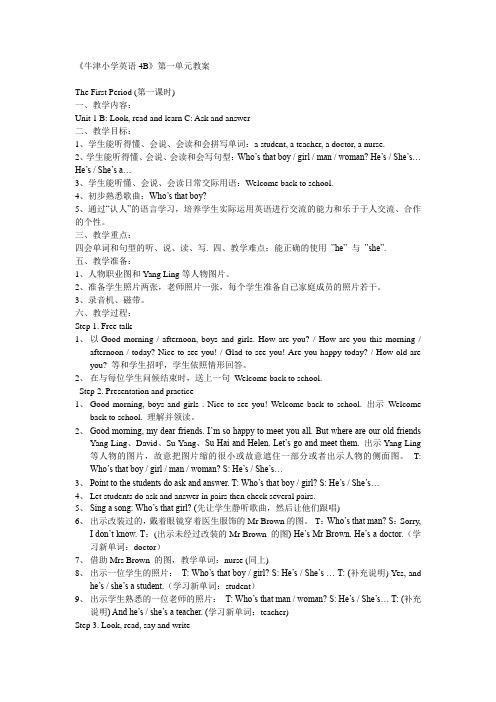
《牛津小学英语4B》第一单元教案The First Period (第一课时)一、教学内容:Unit 1 B: Look, read and learn C: Ask and answer二、教学目标:1、学生能听得懂、会说、会读和会拼写单词:a student, a teacher, a doctor, a nurse.2、学生能听得懂、会说、会读和会写句型:Who’s that boy / girl / man / woman? He’s / She’s… He’s / She’s a…3、学生能听懂、会说、会读日常交际用语:Welcome back to school.4、初步熟悉歌曲:Who’s that boy?5、通过“认人”的语言学习,培养学生实际运用英语进行交流的能力和乐于于人交流、合作的个性。
三、教学重点:四会单词和句型的听、说、读、写. 四、教学难点:能正确的使用”he” 与”she”.五、教学准备:1、人物职业图和Yang Ling等人物图片。
2、准备学生照片两张,老师照片一张,每个学生准备自己家庭成员的照片若干。
3、录音机、磁带。
六、教学过程:Step 1. Free talk1、以Good morning / afternoon, boys and girls. How are you? / How are you this morning /afternoon / today? Nice to see you! / Glad to see you! Are you happy today? / How old are you? 等和学生招呼,学生依照情形回答。
2、在与每位学生问候结束时,送上一句Welcome back to school.Step 2. Presentation and practice1、Good morning, boys and girls . Nice to see you! Welcome back to school. 出示Welcomeback to school. 理解并领读。
- 1、下载文档前请自行甄别文档内容的完整性,平台不提供额外的编辑、内容补充、找答案等附加服务。
- 2、"仅部分预览"的文档,不可在线预览部分如存在完整性等问题,可反馈申请退款(可完整预览的文档不适用该条件!)。
- 3、如文档侵犯您的权益,请联系客服反馈,我们会尽快为您处理(人工客服工作时间:9:00-18:30)。
Unit 1 Our school subjects一、教材分析:本单元的主要内容是谈论新学期的科目和课程表。
重点是科目的名称以及与此相关的句型。
通过谈论彼此喜欢的科目,在此情境下练习句型What subjects do you like? I like…并学习日常交际用语Welcome back to school. Nice to meet you.本单元重点词汇有:timetable, PE, Science, fun, go to, playground, afternoon, school, subject, see, Chinese, Maths, Art, Music, lesson, Monday.学习字母a在单词中的读音。
二、教学目标:1. 能正确地听、说、读、写单词school, subject, see, Chinese, Maths, Art, Music, lesson, Monday.2. 能听懂、会说、会读日常用语与句型:What subjects do you like? I like… Welcome back toschool. Nice to meet you.3. 能听懂、会说、会读词汇:timetable, PE, Science, fun, go to, playground, afternoon, school,subject, see, Chinese, Maths, Art, Music, lesson, Monday.4. 会诵读童谣Subjects。
5. 能听懂、会说、准确发音字母a。
三、教学重点:1.句型:What subjects do you like? 及其回答I like…2.词汇:school, subject, see, Chinese, Maths, Art, Music, Monday, lesson.3. 语音:字母a在单词中的读音四、教学难点:1.句型:What subjects do you like? 及其回答I like…在语境中的正确运用。
2.词汇:subject, Chinese, Maths的读音,subject和lesson词义上的区别。
语音:字母a在单词中的读音。
五、教学安排第一课时Story time第二课时Fun time第三课时Cartoon time & Sound time第四课时Rhyme time & Checkout time & Ticking time第五课时综合复习Unit 2 After school一、教材分析:本单元主要话题是谈论课外活动,重点内容是一周七天的名称以及如何谈论课后活动的相关句型。
句型和日常用语:I have… He/She has … What day is it today? It’s …. What a pity! All right. 词汇:Wednesday, Saturday, Sunday, Tuesday, Thursday, Friday. 语音:字母a在单词中的读音二、教学目标:1. 能正确地听、说、读、写单词:Wednesday, Saturday, Sunday, Tuesday, Thursday, Friday, getup.2. 能听懂、会说、会读日常用语与句型:I have… He/She has… We don’t have… What day isit today? It’s… What a pity! All right.3. 能听懂、会说、会读词汇:after school, go, match, today, when, every, day, Wednesday,Saturday, Sunday, Tuesday, Thursday, Friday, get up.4. 会唱歌曲:Days of the week.5. 能听懂、会说、准确发音字母a。
三、教学重点:1. 句型:I have… He/She has… What day is it today? It’s… What a pity! All right.2.词汇:Wednesday, Saturday, Sunday, Tuesday, Thursday, Friday.3.语音:字母a在单词中的读音。
四、教学难点:1.句型:has的用法。
2.词汇:Wednesday, Saturday, Sunday, Tuesday, Thursday, Friday等单词的读音和拼写。
语音:字母a在单词中的读音。
五、教学安排第一课时Story time第二课时Fun time & story time第三课时Sound time & cartoon time第四课时Song time & Checkout time & Ticking time第五课时综合复习教后反思:Unit 3 My day一、教材分析:本单元主要围绕一天中什么时间起床、上学、上课、吃饭、娱乐、睡觉而展开,主要词汇和短语有:have lunch, play football, have dinner, go to bed, at night, usually, go to school, in the morning, in the afternoon, go home, homework, watch TV, in the evening.涉及到重点句型是:When do you…? I have/ do/ play/ go to/ …+at+ 时间。
这些句型在前两个单元的学习中都有涉及,并且与学生生活紧密相连。
所以,在本单元的教学中导入新课、创设情境是相对比较容易的。
在课堂上要努力调动学生的兴趣,让学生能够把课堂所学知识应用于实际生活中。
二、教学目标:1. 能正确地听、说、读、写单词:usually, go to school, in the morning, in the afternoon, go home, homework, watch TV, in the evening.2. 能听懂、会说、会读日常用语与句型:When do you…? I … at…3. 能听懂、会说、会读词汇:have lunch, play football, have dinner, go to bed, at night, usually, go to school, in the morning, in the afternoon, go home, homework, watch TV, in the evening.4. 会唱歌曲:When do you get up?5. 能听懂、会说、准确发音字母e和字母组合ee。
三、教学重点:1. 句型:When do you…? I (usually)… at…2. 词汇:usually, go to school, in the morning, in the afternoon, go home, have lunch, have dinner, play football, go to bed.3. 语音:字母e和字母组合ee在单词中的读音。
四、教学难点:1.句型:When do you…? I (usually)… at…2.词汇:有关日常活动的短语。
五、教学安排第一课时Story time第二课时Fun time & Story time第三课时Sound time & Cartoon time第四课时Song time & Checkout time & Ticking time第五课时综合复习教后反思:Unit 4 Drawing in the park一、教材分析:本单元围绕在公园里的所见、所闻、所画等内容展开,主要学习句子What can you…?/ Can you …? I can see … 等。
由于是特殊疑问句,其语序与汉语有所不同,所以要引导学生重点理解。
本单元主要词汇有:drawing, easy, difficult, try, hill, again, park, draw, flower, them, boat, river, lake.语音部分学校字母e在单词中的读音。
二、教学目标:1. 能正确地听、说、读、写单词:park, draw, flower, them, boat, river, lake.2. 能听懂、会说、会读日常用语与句型:What can you see? I can see… Good idea!3. 能听懂、会说、会读词汇:drawing, easy, difficult, try, hill, again, park, draw, flower, them,boat, river, lake.4. 会唱歌曲:What can you see?5. 能听懂、会说、准确发音字母e。
三、教学重点:1. 句型:What can you see…? I can see…2. 词汇:park, draw, flower, them, boat, river, lake.3. 语音:字母e在单词中的读音。
四、教学难点:1.句型:What can you see over there? I can see…2.词汇:drawing, easy, difficult, try, hill, again的读音。
3.语音:字母e在单词中的读音。
五、教学安排第一课时Story time第二课时Fun time & Story time第三课时Sound time & Cartoon time第四课时Song time 、Checkout time、Ticking time第五课时综合复习Unit 4 The third period二次备课一、教学内容:Cartoon time & Sound time二、教学目标:1. 复习上节课所学的关于公园物品的单词,能进一步熟练拼读。
2. 复习上节课所学的句型,能进一步熟练运用。
3. 能够阅读并理解卡通部分的幽默,并能表演故事内容。
4. 能够模仿卡通部分的故事内容续编故事。
5. 能总结归纳e的发音/e/三、教学重点:1. 阅读并理解卡通部分的幽默,并能表演故事内容。
2. 能总结归纳e, ee的发音/i:/四、教学难点:熟练运用本单元的词汇和句型描述人物的日常活动五、课前准备:1.准备录音机和磁带2.教学图片、多媒体课件3.板书准备:本节课课题、教学目标六、教学过程:Step 1 Warming up & Free talk1. Enjoy the song: Row your boat(课前就可以播放继续让学生熟悉)2. T: Life is interesting. Last lesson, we went to the park and thetheatre. Today, we will go to another interesting place – Amusement park.Let’s go. 课件出示图片3. T: If you can get stars when you’re playing. Let’s see which teamcan get more stars. (学生分成两组)Ready? Go!Step 2 Review1. T: Look! It’s a Fun house. We can play games in it. Let’s playFinding Differences first.T: You should find the three differences in these two pictures.展示学生自己设计的公园,学生!一共两组图片。
